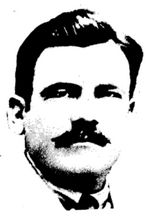Other emergency issues in Sonora in 1913
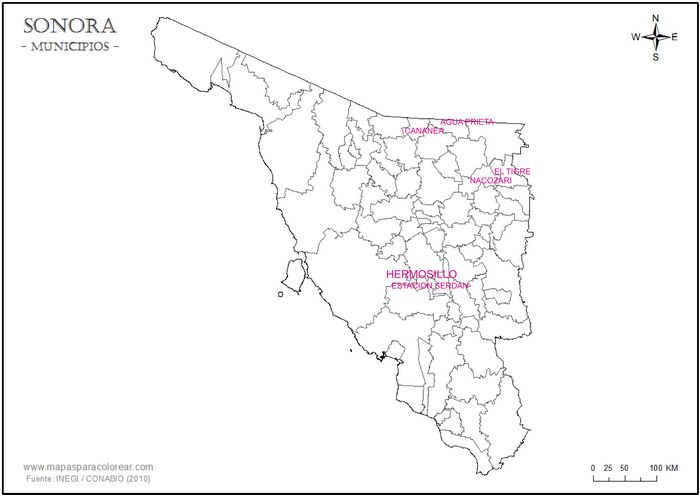
As stated, the outbreak of the revolution led to the hoarding of silver coins and banknotes and the consequent shortage of currency had serious effects on everyday life. The revolutionary government attempted to remedy the situation with its own Estado de Sonora notes but in the meantime various local issues were made.
Cananea
By September 1913 it was reported that as only a few hundred pesos remained in circulation in Cananea. businesses could not give change and some wanted to close. Other shops and canteens issued bearer cheques for one and two pesos redeemable on the Compañía Bancaria Mercantil, although none of them survived. Are these different from, or merely a misunderstanding of, the Banco Mercantil de Cananea issue?
Agua Prieta
On 19 November 1913 the government wrote to the Comisario de Policía in Agua Prieta that it had learnt that the Moctezuma Copper Company S. A. had issued $5,000 in $1 notes in the form of cheques drawn on the banks of Douglas[image needed], and that an unnamed individual had issued another $1,000 in notes of the same value. The same day the Comisario, Federico Meza, sent the government examples of the notes (cheks) that it had asked about. Meza said that these were not issues (emisiones de bonos) since, whenever one collected a sum of five pesos or more, the businesses that had issued these cheques would exchange them for notes of the Estado de Sonora or other banks. They merely made up for the shortage of low denomination Estado de Sonora notesAGHES, Fondo Oficialidad Mayor, tomo 2971, telegram to Comisario de Policía, Federico Meza, Agua Prieta, 19 November 1913.
Plutarco Elías Calles
The unnamed individual might have been the future president Plutarco Calles in Agua Prieta, for whom three values, for 25 centavos, 50 centavos and one peso, dated 10 November 1913 are known. However, these notes do not carry any mention of the ability to be exchanged, to which Meza referred.
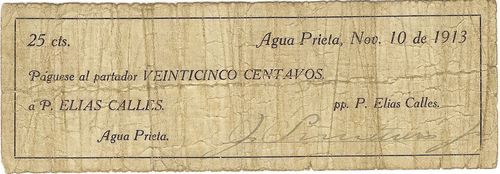
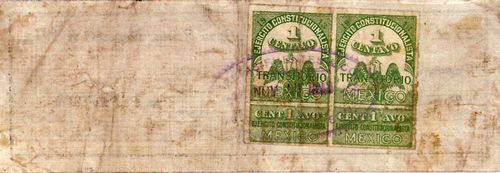 M3831 25c Plutarco Elías Calles
M3831 25c Plutarco Elías Calles
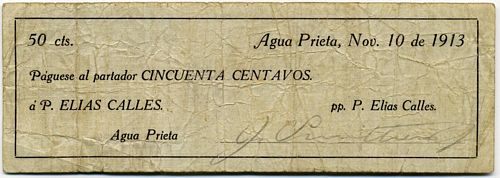
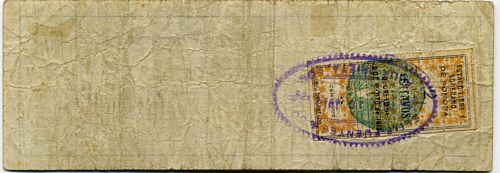 M3832 50c Plutarco Elías Calles
M3832 50c Plutarco Elías Calles

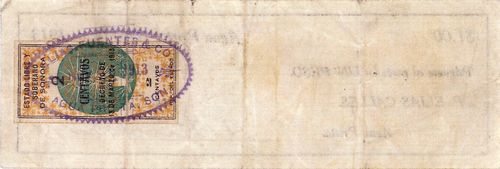 M3833 $1 Plutarco Elías Calles
M3833 $1 Plutarco Elías Calles
These notes are signed by J. Smithers, Jr. and have revenue stamps and an oval cancellation ‘Elias Fuentes & Co. Nov 11, 1913’ on the reverse.
|
Calles’ political life dated from 1911 when he ran unsuccessfully for Congress. Like Obregón, with whom he was closely linked, Calles did not support Madero but he and Maytorena shared mutual friends, who prevailed upon Maytorena to appoint Calles Comisario de Policía of Agua Prieta and Cananea. With the death of Madero, Calles pledged his allegiance to the Constitutionalists, siding with Carranza in his quarrel with Villa and Maytorena. Between 1915 and 1918, he was Carranza’s minister of industry, commerce and labour, governor of Sonora, and its military boss. In 1919, he abandoned Carranza for Obregón, served briefly as minister of war under de la Huerta, later as Obregón’s minister of Gobernación, and then as president of Mexico. He died in 1945. |
|
|
J. Smithers, Jr. The Smithers were lifelong friends of Calles. In 1906 Santiago Smithers persuaded Calles to take over the management of the Excélsior flourmill but in 1910 the Banco de Sonora foreclosed on the mill. That year they sent up a business called Elías Smithers y Compañía trading in fertiliser, seeds and flour, which closed in April 1911, causing Calles to go back on the bottle. |
 |
On 27 November the Agente Fiscal in Agua Prieta sent three examples of money that was circulating in Agua Prieta:
(1) a cheque of The Moctezuma Copper Company, for $1, drawn on the Bank of Douglas;
(2) a cheque of the Compañía Bancaria de Cananea, for $2, drawn on the Bank of Bisbee; and
(3) a time-limited deposit receipt (recibo de depósito a plazo fijo) of the Compañía Bancaria de Cananea, for $2.
He added that he had seen notes of lower values of the Compañía Bancaria, and of the Moctezuma Copper CompanyAGHES, Fondo Oficialidad Mayor, tomo 2971 letter Randall, Tesorero General, to Secretario de Gobierno, 9 December 1913.
El Tigre and Moctezuma
In November 1913 various foreign businesses in Cumpas issued $1 notes, the notes being preferred to the Estado de Sonora issue.
The Tigre Mining Company

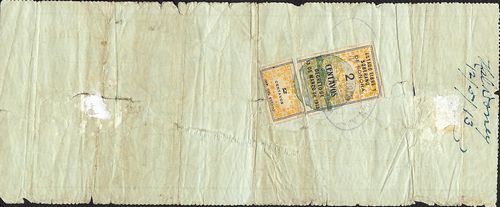 M3845 $1 The Tigre Mining Company
M3845 $1 The Tigre Mining Company
| series | from | to | total number |
total value |
||
| $1 | C | includes number 10814 |
Thus the Tigre Mining Company S.A., at El Tigre, issued a cheque for one peso drawn on the Bank of Douglas dated 11 November 1913, and signed by L. R. Budrow.
|
L. R. Budrow worked for the various successive owners of the El Tigre mine during the first few decades of the twentieth century. He was appointed superintendant in November 1909The Bisbee Daily Review, 9 November 1909 and by 1925 was vice-president and general manager of the Lucky Tiger-Combination Gold Mining Company. On 15 September 1912 rebels under the command of José Inez Salazar captured the town of El Tigre after two attacks. While the rebels were attacking the town, a detachment of federal troops was within a distance of nine miles but made no effort to aid the garrison that was eventually driven from the place. The rebels looted the store of the Lucky Tiger Combination Gold Mining Co. and departed with 21 bars of bullion. A threat was made to hold L. R. Budrow, his assistant manager R. T. Mishler, and H. L. Nix, the manager of the El Tigre Merchandise Co., as hostages for a $100,000 ransom, but it was not carried out (though US newspapers reported that Budrow was being held a prisoner). The federal troops returned to the town after the rebels departedThe Engineering and Mining Journal, vol. 94, no. 12, 21 September 1912. |
The Moctezuma Copper Company
In November it was reported that the Moctezuma Copper Company had issued 5,000 cheques for one peso drawn on the Bank of Douglas[image needed]AGHES, Fondo Oficialidad Mayor, tomo 2971, telegram to Comisario de Policía, Federico Meza, Agua Prieta, 19 November 1913.
| from | to | total number |
total value |
|
| $1 | 5,000 | $5,000 |
On 24 November J. E. Rivera, the Presidente Municipal of Cumpas, reported that various foreign concerns had issued $1 scrip (varios giros de a un pesos)AGHES, Fondo Oficialidad Mayor, tomo 2971, telegram Rivera, Cumpas, to governor, 24 November 1913 and the next day the governor told him to make sure they were retired before the end of the month. The Presidente Municipal ordered their prohibitionAGHES, Fondo Oficialidad Mayor, tomo 2971, telegram Rivera, Cumpas, to governor, 25 November 1913.
In addition, there exists bearer cheques from the Moctezuma Copper Company for 25c, $1 and $2 dated 20 December 1913 drawn on The Bank of Douglas. Obviously the company had also been told to withdraw its original notes but, like the Cananea Consolidated Copper Company, allowed to issue bearer cheques.
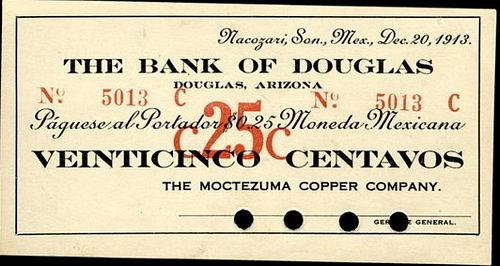
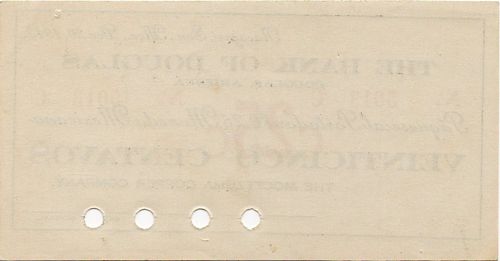 M3862b 25c The Moctezuma Copper Company
M3862b 25c The Moctezuma Copper Company
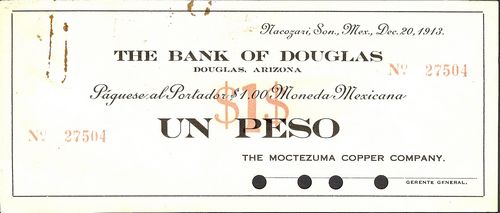
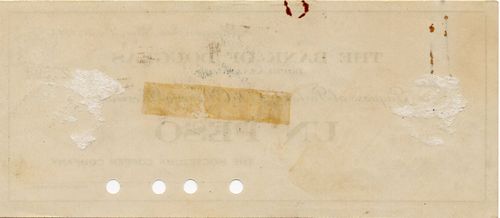 M3863 $1 The Moctezuma Copper Company
M3863 $1 The Moctezuma Copper Company
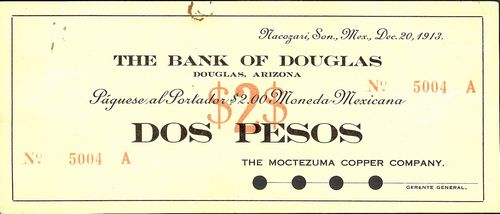
 M3864 $2 The Moctezuma Copper Company
M3864 $2 The Moctezuma Copper Company
| from | to | total number |
total value |
||
| 25c | includes number 5013 C | ||||
| $1 | includes number 27504 | ||||
| $2 | includes number 5004 A |
Ures
In October 1913 the shopkeepers of Ures asked their Prefecto, Jesús A. Cano, for permission to issue 600 pesos in bonds (bonos) to the values of 25c, 50c $1, $2 and $3, such notes to be signed by the businesses, stamped by the Prefectura and backed by a deposit left with the Prefecto himself. At that time any storekeeper who did not have change was forced to give out a vale that could only be used in the same store. These notes would have eased the smallest transactions for anyone who wanted to redeem a note would have been able to draw on the cash deposited with the Prefecto. The request was passed on to the state government but on 22 October the killjoy Secretary of State Juan Sánchez Azcona turned it downAGHES, Fondo Oficialidad Mayor, tomo 2971, telegram Cano, Ures, to Secretario de Estado, 18 October 1913: telegram Secretario de Estado to Cano, Ures, 22 October 1913.
Estación Serdán (Estación Torres)
Estacion Serdán is in the municipio of La Colorada. On 17 April 1914 the Comisario de Policia there, in reply to a query from the governor’s office, reported that during late November and early December 1913 two Chinese shopkeepers, José Gui Long and Juck Luey, had issued vales for 5c, 10c and 15c[images needed], because of a lack of small chargeAGHES, Fondo Oficialidad Mayor, tomo 2993.
Withdrawal
On 6 December Carranza’s Secretario de Hacienda, at Hermosillo issued a circular (núm. 2) outlawing these vales after 31 December.
This Secretaría has discovered that some banking institutions and certain Mexican and foreign business houses have put into circulation small-denomination bearer scrip and as this practice is prohibited by Article 37 of the Ley de Instituciones de Crédito and punished by the respective Code it is suggested that you exercise the strictest vigilance to ensure that the law is not abused, setting the thirty-first of this month as the date by which such scrip should be redeemed by its issuers and the emission amortised, with the understanding that if they fail to do so the infractors will be consigned to the appropriate authorities.
On 14 January 1914 Carranza sent a telegram to Calles at Agua Prieta that he had learnt that certain mining and banking companies, particularly from Cananea and Nacozari, were continuing to circulate low value notes (vales al portador de pequeño valor). As his circular had outlawed such vales, he ordered Calles personally to visit these places and put a stop to this practiceCEHM, Fondo MVIII, telegram Carranza to Calles, 14 January 1914. A case of poacher turning game-keeper.
On 12 February 1914 Maytorena issued his decree (núm. 40) for fractional notes of five and ten centavos. A newspaper reporting this said that all companies and individuals had been forbidden by the government to issue or circulate their script and also warned to redeem any that was outstanding under penalty of being finedTucson Daily Citizen, 18 February 1914, which suggests that some might still have been in circulation in February 1914.

